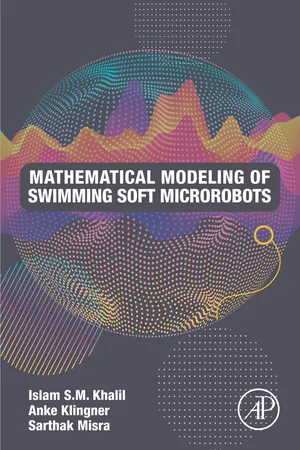
Mathematical Modeling of Swimming Soft Microrobots
- 240 pages
- English
- ePUB (mobile friendly)
- Only available on web
Mathematical Modeling of Swimming Soft Microrobots
About This Book
Mathematical Modelling of Swimming Soft Microrobots presents a theoretical framework for modelling of soft microrobotic systems based on resistive-force theory. Microorganisms are highly efficient at swimming regardless of the rheological and physical properties of the background fluids. This efficiency has inspired researchers and Engineers to develop microrobots that resemble the morphology and swimming strategies of microorganisms. The ultimate goal of this book is threefold: first, to relate resistive-force theory to externally and internally actuated microrobotic systems; second, to enable the readers to develop numerical models of a wide range of microrobotic systems; third, to enable the reader to optimize the design of the microrobot to enhance its swimming efficiency.
- Enable the readers to develop numerical models of a wide range of microrobotic systems
- Enable the reader to optimize the design of the microrobot to enhance its swimming efficiency
- The focus on the development of numerical models that enables Engineers to predict the behavior of the microrobots and optimize their designs to increase their swimming efficiency
- Provides videos to demonstrate experimental results and animations from the simulation results
Frequently asked questions
Information
Table of contents
- Cover image
- Title page
- Table of Contents
- Copyright
- Dedication
- Biography
- Preface
- Chapter 1: Introduction
- Part I: Fundamentals of the theory of elasticity, electromagnetics, and fluid mechanics
- Chapter 2: Theory of elasticity
- Chapter 3: Theory of electromagnetics
- Chapter 4: Fluid mechanics and resistive-force theory
- Part II: Internally actuated swimming soft microrobots
- Chapter 5: Principles of propulsion by flagella and cilia
- Chapter 6: Examples
- Part III: Externally actuated swimming soft microrobots
- Chapter 7: Principles of propulsion by magnetically actuated soft bodies
- Chapter 8: Examples
- Part IV: Localization and motion control of soft microrobots
- Chapter 9: Localization of soft microrobots
- Chapter 10: Open-loop control of soft microrobots
- Chapter 11: Closed-loop control of soft microrobots
- Appendix A: Quantities and units
- Appendix B: Mathematical derivations
- Appendix C: Electromagnetic systems
- Appendix D: Material constants
- Index